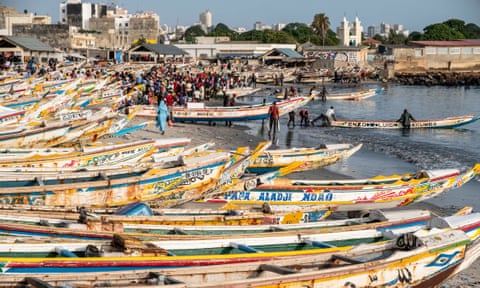It is not the large-eyed dentex’s lucky day. But it is Yelli Diop’s.
The Senegalese fisherman has had a very successful haul, and arrives back on Dakar’s shores with several boxes of fish in the hull. His brightly painted pirogue – a long, narrow canoe used by the fishermen here – is pulled up on the beach, a length of pipe wedged under it to keep it on the sand, and the orangey-pink fish unceremoniously dumped with dozens of its kin into a crate.
Diop opens negotiations with a fish-seller, the sitting queen of her small square of beach, while robed Dakarois, tired fishermen, Chinese buyers, fishwives and children throng past.
Like millions of its brethren that have passed through Dakar’s colourful Soumbedioune fish market before it, the dentex is probably destined for a plate of thiéboudienne, the national dish – caught, sorted, gutted and sold in the late afternoon by men and women working just as their great-great-grandparents did.



Clockwise from main: Fisherman Yelli Diop with some of his day’s catch; shoppers inspect the fish on offer and fishermen sort their catch.
But times are changing. Commercial overfishing to feed European and Asian appetites has emptied West Africa’s waters and destroyed the livelihoods of many artisanal fishing communities, including those in Senegal with its long Atlantic coastline.
Now the fishmongers of Soumbedioune are moving. A new €2m fishing quay, funded by Morocco and sitting across the bay from the existing market, has been finished. It contains an ice factory, a cold room, a fish-processing area and rows of gleaming counters in the retail market. There are fishermen’s lockers, workshops and an office. It should be open by the time Senegal holds presidential elections in February.
The changes are part of a wholesale reinvention of Dakar, which is changing at a rapid pace. Apartment blocks spring up in every vacant plot; the city’s few remaining trees are cut down to make space for them. The stalls of vegetable sellers in the city’s old commune of Ngor were recently bulldozed for a car park. Houses are going up in the old airport, which was closed to commercial flights last year after a new one was built 60km outside the capital.

Some of the fishing families think the closure of their lively if ramshackle market is a sign of the times, and a good thing.
“It stinks here. It’s dirty, it’s hot, it’s disorganised. Over there it’s covered, and more hygienic,” says Khairou Mbang, who cleans fish for a living and is beginning to break into selling them, too.
Mbang used to bring her baby daughter with her to the market, trying to shield her from the sun in the shade of heavy concrete slabs bearing the biggest fish. She hopes her children will have office jobs, or at least go into a less physically taxing profession than hers.
“Life is hard. We don’t want our daughters to come here. I’d rather do anything else, but you can’t change, there’s no other work,” she says.



With growth of 7% in 2017, oil and gas discoveries in the north, and the rapid construction of an entirely new city from scratch near the current, crowded peninsular capital, Senegal is changing rapidly. Nearly half its population still live in poverty, though, and the fishing communities are finding it increasingly hard to make ends meet. West Africa loses £1.8bn (US $2.3bn) a year to illegal, unreported and unregulated fishing.
As more shoppers arrive at Soumbedioune, the smell of sewage floats in the sea air; most of Dakar’s drains are emptied, untreated, into the ocean. A man hacks up swordfish into large hunks, a cloud of flies ascending every time he throws a new piece on to the pile.
Many fishmongers hope that the new market will attract well-to-do buyers who would not usually brave the crowds, smells and dirt of Soumbedioune. Adama Diallo, her broken plastic tabletop nestling between two colourfully painted pirogues, was not convinced.

The new, covered fish market, due to open in February.
“I’ve never been, and I won’t go,” she says, rearranging a pile of pink-tinged mullet. “A ghost used to live over there.”
She calls at prospective clients to buy her fish as they amble by, but with dozens of other sellers at Soumbedioune, business for Diallo is slow. Looking over at the low, maroon building behind its metal gate, she points out the obvious.
“Not all of us will fit in there,” she says.
“I’ve been here since I was born. My father was a fisherman – my father, and his father too. All fishermen. Let us stay,” she says.
Follow Guardian Cities on Twitter, Facebook and Instagram to join the discussion, and explore our archive here
